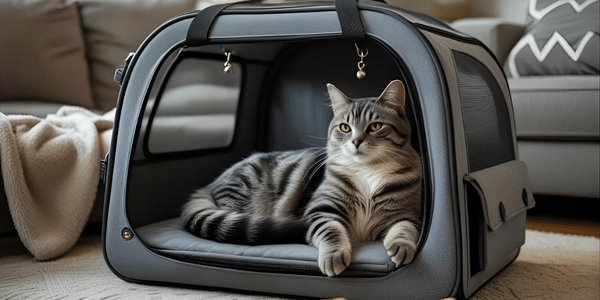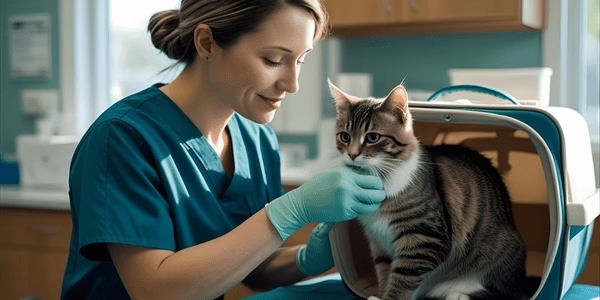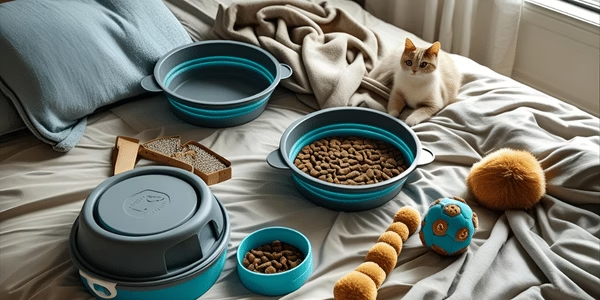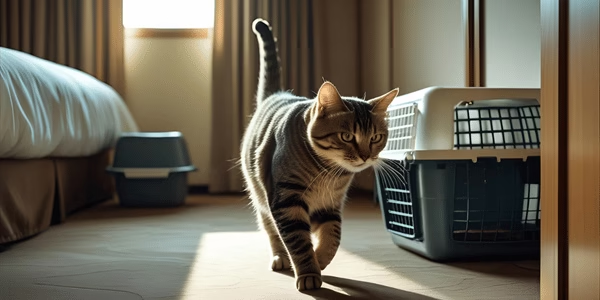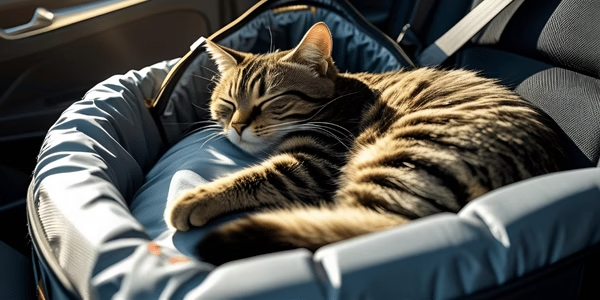Heads up: This post contains Amazon affiliate links. That means if you click through and buy something, I may earn a small commission, at no extra cost to you. I only recommend products I’ve either used myself or researched the heck out of. Your support helps keep this blog (and my cat) running.
Traveling with a cat is one of those ideas that seems cute.
In your head, you’re picturing a well-behaved little loaf peeking out of a stylish carrier, softly purring while gazing out the window.
Reality check? You get three blocks into the trip and your cat’s already howling like they’re being abducted by aliens. There’s drool, fur, maybe even poop. It’s a full-on meltdown.
So, if you’re planning to take your cat on the road (or in the air), you need more than optimism, you need a game plan.
Here are 10 cat travel tips that actually work to keep both you and your feline friend from losing your minds.
1. Leave the Carrier Out (Way Before You Need It)
If you only ever drag out the carrier when it’s time for a vet visit, your cat has one association with it: doom.
So of course they panic the second it shows up.
Fix that.
Leave the carrier out days, or better yet, weeks, before your trip. Make it part of your home, not some mysterious torture box.
Drop a blanket inside. Toss in some treats. Sprinkle in a little catnip. Feed them nearby. Basically, do anything to make it feel like a chill hangout spot.
Eventually, your cat will wander in on their own, and you’ll avoid the “stuffing a tornado into a shoebox” routine on travel day.
2. Use a Carrier That Doesn’t Suck
Look, not all carriers are created equal.
Some are more like plastic prisons with zero ventilation and an impossible loading door. Others actually make travel easier, for both of you.
Here’s what you want:
- Soft-sided
- Top and front openings
- Mesh panels for airflow
- Padded interior
- Airline-approved if you’re flying
- Bonus if it fits under a plane seat
The Sherpa Deluxe Carrier ticks all those boxes and doesn’t look like it was designed in the ’90s.
Skip the clunky plastic crates unless you’re transporting livestock.
3. Vet Visit = Non-Negotiable
I get it, you’re busy. But this one’s a must.
A quick checkup can catch stuff you don’t want flaring up mid-trip. Like dental pain. Or motion sickness. Or anxiety so intense your cat turns into the Tasmanian Devil.
Also, if you’re flying, airlines usually require a health certificate from your vet issued within 10 days of travel. Skip this, and you’re not going anywhere.
While you’re there, ask your vet if your cat’s a good candidate for Gabapentin or Cerenia, two common, vet-approved options for calming anxious or motion-sick cats.
4. Build a Travel Kit for Your Cat
You wouldn’t go on a road trip without your own essentials, right? Your cat’s the same way.
Here’s what goes in their bag:
- Travel litter box + litter scoop
- Ziplock bags of food
- Collapsible food and water bowls (RELATED: Cat Hydration Guide)
- Bottled water (avoid switching tap sources)
- Familiar blanket or shirt that smells like you
- Toys (but not the loud ones)
- Treats
- Medications
- Calming spray or collar
- Paper towels, baby wipes, poop bags
- Vet papers and ID tag
Sounds like a lot? Wait until you’re three hours from the nearest pet store and your cat poops in the carrier.
5. Use Calming Aids (Yes, They Work)
If your cat turns into a demon in a moving vehicle, it’s not personal, they’re just freaked out. Enter: calming aids.
Here’s a breakdown of what actually works:
| Product | Type | How It Helps |
| Feliway Spray | Synthetic pheromones | Mimics “happy” cat signals |
| Zylkene | Natural supplement | Calms without drowsiness |
| ThunderShirt | Gentle compression | Reduces over-stimulation |
| Comfort Zone Collar | Pheromone collar | Great for multi-day trips |
Test any of these before your trip. Some cats become zen monks. Others couldn’t care less. Better to find out before you’re halfway through Kansas.
6. Don’t Feed Right Before Leaving
This one’s simple: a full stomach + motion = barf.
Feed your cat 4–6 hours before departure. That gives them time to digest, use the litter box, and reduce the odds of “surprise soup” in their carrier.
Water’s fine up to departure time, and even during the trip, if they’ll take it.
If your cat’s especially prone to nausea, ask your vet about Cerenia. It’s an anti-nausea med made specifically for pets. Basically, it’s Dramamine for cats… minus the grogginess.
7. Do Practice Runs
Don’t wait until go-time to find out your cat hates the car.
A week or two before your trip, start doing short drives. Use the same carrier, the same blanket, the same spray.
Start with 5-minute loops. Then 10. Then 20.
Reward your cat with a treat after each trip. This isn’t just practice, it’s psychological conditioning.
You’re teaching them: “Hey, this moving box isn’t trying to kill you.”
The more normal you make it, the less panic you’ll see on the big day.
8. Know Your Cat’s Personality Type
Some cats are little adventurers. Others will scream like they’re being murdered at the first sign of change.
Here’s a quick guide:
| Cat Type | Behavior | Travel Game Plan |
| The Explorer | Curious, calm, alert | Just basic prep needed |
| The Overthinker | Meows, hides, drools | Add pheromones, limit stimulation |
| The Drama Queen | Screams, scratches, escapes | Definitely use calming aids, maybe meds |
| The Elder | Slow, stiff, sensitive | Short trips, lots of breaks, temp control |
Tailor your plan to the cat you actually have, not the Instagram-ready version in your head.
9. Stick to the Script (aka Routine)
Cats are all about routine. Wake, stretch, eat, nap, judge humans, nap again.
Travel disrupts all that. So do what you can to stick to the script.
Feed them at their normal times. Use the same food, same bowls, same litter. Keep their blanket close. Maintain any little rituals you can.
It helps anchor them, even in unfamiliar places.
If you’re staying somewhere new, start them off in one small, quiet room. Let them explore gradually. Don’t shove them into the middle of a noisy living room with strangers and loud TVs.
10. Let Them Chill After Arrival
So you’ve made it. You’re tired. They’re tired. But your job’s not quite done.
Give your cat time to decompress.
Pick a quiet room. Set up their stuff. Let them out of the carrier and leave them alone. Seriously, don’t poke, prod, or force interaction.
They’ll come out when they’re ready.
Pushing them too soon could undo all the work you did to get here. You made it this far, don’t blow it now.
Bonus: Flying with Cats? Here’s the Real Talk
Flying with a cat is doable, but it’s not for the faint of heart. Here’s what most people forget to mention:
- Book early: Airlines have limited pet slots per flight.
- Carrier counts as a carry-on: Plan accordingly.
- Security will make you take your cat out: Get a harness. Practice. Pray.
- Never sedate without vet advice: Some sedatives are dangerous at altitude.
- Use pee pads in the carrier: Better to have them and not need them.
- Attach ID and documents to the carrier: Name, phone, vet info, etc.
Bottom line: know your airline’s pet policy backward and forward. Print it. Highlight it. Be ready to show it to the gate agent who’s never seen a cat in their life.
Real Case Study: One Cat’s Chill Road Trip
Meet Leo. A 5-year-old orange tabby with an attitude.
His owner, Maya, had to drive from Colorado to Arizona, roughly 12 hours over two days.
She started prepping 3 weeks out:
- Left the carrier open with toys and treats
- Sprayed Feliway every day
- Took Leo on short drives twice a week
- Fed him early on travel day and gave him a Gabapentin dose 90 minutes before leaving
Result?
Leo snoozed most of the way. Zero accidents. Minimal meowing. He adjusted to the hotel like a champ.
Prep + practice = peace.
What the Experts Say
Let’s toss in some wisdom from people with letters after their names.
Dr. Karen Becker, holistic vet:
“Cats don’t just fear motion, they fear unpredictability. Your job is to bring the familiar with you.”
Pam Johnson-Bennett, cat behaviorist:
“Don’t underestimate the power of scent. A blanket or T-shirt that smells like home can anchor your cat emotionally during travel.”
So yeah, turns out all that prep isn’t just busywork. It’s legit science.
Final Thoughts: Yes, You Can Travel with a Cat
Will it be perfect? Probably not.
Will it be peaceful if you just throw them in a carrier and go? Definitely not.
But if you plan, prep, and give your cat the tools to cope? You’ll be shocked how well they handle it.
Start small. Build up. Learn what works for your cat.
And remember: the goal isn’t to make your cat love travel. The goal is to make it suck less, for everyone.
Frequently Asked Questions (FAQs)
Q: Can I give my cat Benadryl for travel anxiety?
A: While Benadryl is sometimes used for allergies in cats, it’s not typically recommended for travel stress without vet approval. It can cause paradoxical excitement in some cats and isn’t always safe. Opt for cat-specific anti-anxiety meds like Gabapentin.
Q: Should I sedate my cat before flying?
A: Most airlines discourage heavy sedation due to respiratory risks at altitude. Talk to your vet about light, short-acting anti-anxiety meds instead. Always test medications before travel day.
Q: What’s the best way to calm a hyperactive kitten during travel?
A: Kittens often respond well to pheromone sprays, soft carriers, and puzzle toys. Try interactive toys like the Catit Treat Puzzle to occupy their mind during car rides.


